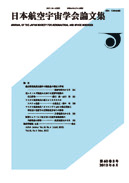All issues

Volume 58, Issue 676
Displaying 1-4 of 4 articles from this issue
- |<
- <
- 1
- >
- >|
Articles
-
Hajime ITOH, Hirokazu HONDA2010 Volume 58 Issue 676 Pages 123-129
Published: 2010
Released on J-STAGE: June 11, 2010
JOURNAL FREE ACCESSThe purpose of this study was to examine the structure of reattaching boundary layers downstream of a quasi-two-dimensional compression corner in a gun tunnel at Mach number 10 using a glow spark technique. An analytical model predicted well a location of a high aerodynamic heating region in laminar reattaching boundary layers. An indication of presence of Görtler vortices was found; the vortices may play an important role in the transition. Furthermore, the flow was unsteady and accompanied by a shock wave rippling. The rippling was probably not caused by the vortices, since characteristic length scales of the two phenomena were completely different. A slip line generated due to shock/shock interaction had little effect on the transition, because it was apart from the boundary layer.View full abstractDownload PDF (874K) -
Katsuyoshi FUKIBA, Nobuyuki TSUBOI, Hiroaki KOBAYASHI2010 Volume 58 Issue 676 Pages 130-137
Published: 2010
Released on J-STAGE: June 11, 2010
JOURNAL FREE ACCESSNumerical simulation on the Air Data Sensor System (ADS), which measures the flow angles and Mach number using the surface pressures on a nose cone, was conducted in this study. The effect of the half cone angle on the flow angle and Mach number measurement was investigated. As a result, we found that a large half cone angle achieves a high sensitivity at the flow angle measurement. It was also found that a small half cone angle achieves a high sensitivity at the Mach number measurement. To satisfy these conflicting requests, we proposed a new shape nose cone which has two different gradients. The high sensitivity was achieved at both the flow angle measurement and Mach number measurement by this new shape nose cone.View full abstractDownload PDF (546K) -
Kazuyuki HIGASHINO, Masatoshi SUGIOKA, Takao KOBAYASHI, Ryojiro MINATO ...2010 Volume 58 Issue 676 Pages 138-145
Published: 2010
Released on J-STAGE: June 11, 2010
JOURNAL FREE ACCESSLiquefied Natural Gas (LNG) is lower cost, higher density and easier handling than Liquefied hydrogen (LH2), therefore, is expected as the most promising candidate for the next generation rocket propellant. For LNG propellant, a full expander or an expander cycle rocket engine with regenerative cooling system is expected because its molecular weight is middle value between LH2 and Kerosene. Temperature of turbopump driven LNG gas should be higher to improve the specific impulse or combustion pressure for these rocket engine. In this case, coking of LNG in heat exchanger or regenerative cooling system becomes a significant problem. In the present study, two coking inhibition methods, n-C6H14 coating and graphite coating, are presented and their effects are evaluated. Contrary to our expectation, the former method is accelerated the LNG pyrolysis, resulting of coking promotion. On the other hand graphite coating can successfully inhibit coking up to 973K.View full abstractDownload PDF (867K) -
Kazuyuki HIGASHINO, Shinichi KOMAZAKI, Yousuke SASAYAMA, Kenichi KIMOT ...2010 Volume 58 Issue 676 Pages 146-151
Published: 2010
Released on J-STAGE: June 11, 2010
JOURNAL FREE ACCESSFor the regenerative cooling cycle LNG rocket engines, improvement Nickel Electroforming technology and analysis are the major problem because of high reliability and low cost at the design and fabrication. This paper describes analysis methods, results and the successful Improved Nickel Electroforming of the stress and strain level at the Electron beam heat zone.View full abstractDownload PDF (450K)
- |<
- <
- 1
- >
- >|